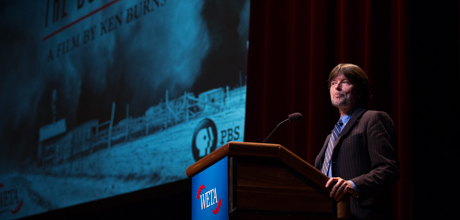Award-winning filmmaker Ken Burns gave a George Washington University Lisner Auditorium audience a sneak peek on Oct. 17 at “The Dust Bowl,” a documentary that chronicles one of the worst manmade ecological disasters in American history with first-person accounts of more than two dozen survivors.
A “10-year apocalypse, almost biblical in its proportions,” as Mr. Burns characterized it, the Dust Bowl of the 1930s was caused by a severe drought and poor wheat farming practices, which left topsoil loose and exposed to high winds that picked it up and blew devastation on a 150,000-square-mile area across Oklahoma, Texas, Kansas, Colorado and New Mexico.
After a 40-minute preview of the film—a production of Florentine Films and WETA, Washington, D.C.—Mr. Burns participated in a question-and-answer session with Peter Miller, a senior editor at National Geographic, and Cal Crabill, a Dust Bowl survivor. Jim Axelrod, national correspondent for CBS News, led the discussion.
In his introduction before the screening, Mr. Burns said the film’s reliance on its 26 in-depth survivor interviews is what gives it “substance and guts.” He said he was “shocked” he used so many different interviews, but given the “magnitude” of the event, it made sense.
One of those survivors, Mr. Crabill, recounted what it was like to live through the period as a 10-year-old, noting the storms, so big and dark, looked like a mountain range in the distance—only the mountain range was moving toward you.
“I’m speaking for my parents, who are no longer here,” he said.
That’s one reason Mr. Burns and his team worked with such urgency in producing the documentary, he said. In a few years, stories of the survivors will be lost with their passing; since the film was shot, five of those interviewed have died.
Although the drought affecting this same area of the country currently is more severe, it isn’t yet as prolonged, said Mr. Miller. They’re “getting a little taste of what happened, but they’re a long way from the kind of complete devastation that we saw in the Dust Bowl.” Mr. Miller said the rising temperature of the Earth, in part, is causing problems; water evaporates before it can be absorbed in the soil.
“The Dust Bowl,” a two-part, four-hour series, premieres Nov. 18 and 19 at 8 p.m. on PBS.


